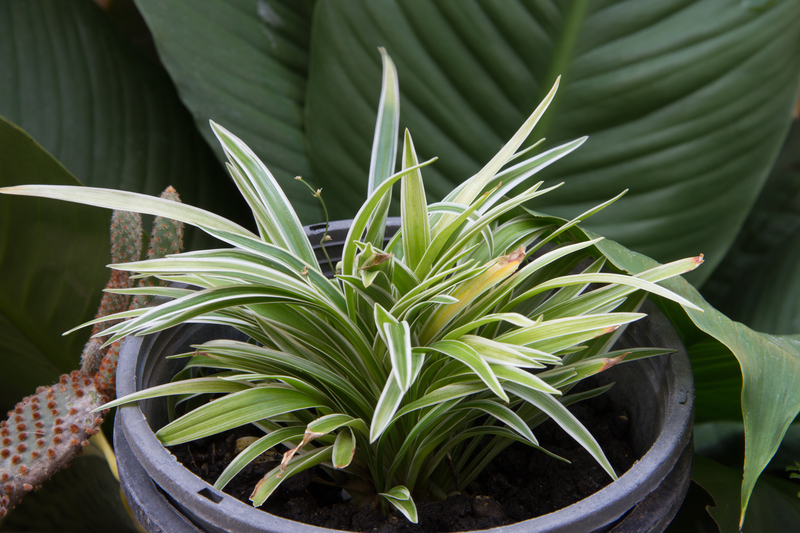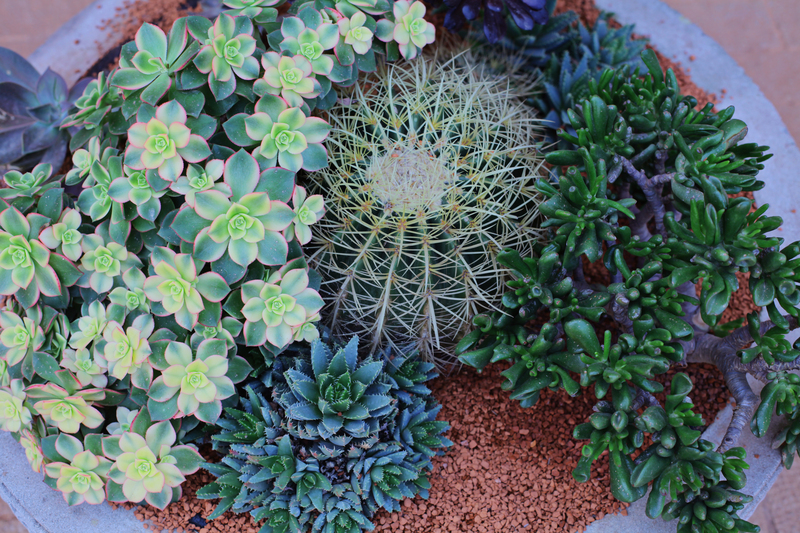Transform Walls into Gardens with Vertical Gardening
Posted on 14/09/2025
Transform Walls into Vibrant Gardens with Vertical Gardening
Are you searching for a way to enhance your living space, add lush greenery, and make the most of limited room? Vertical gardening is revolutionizing how we think about plants, giving everyone--regardless of space limitations--the chance to transform walls into gardens. This eco-friendly approach not only beautifies surroundings but also improves air quality, boosts mood, and maximizes your home's potential. In this comprehensive guide, discover everything you need to know about vertical gardens: from benefits and designs to plant selection and maintenance tips.

What Is Vertical Gardening?
Vertical gardening refers to the practice of growing plants upward--on walls or vertically stacked structures--rather than along the ground. Think of living green walls, hanging planters, trellises with vines, or pocket-filled panels brimming with herbs and flowers. With a creative combination of containers, frames, and plant species, even the smallest spaces can burst with wall gardens and lush greenery.
Why Choose Vertical Gardens?
- Maximizes Small Spaces: Perfect for urban dwellers with limited real estate. Grow more in less space!
- Enhances Aesthetics: Instantly upgrades dull walls to captivating living art pieces.
- Improves Air Quality: Plants filter pollutants, add oxygen, and boost humidity.
- Thermal and Acoustic Insulation: Living walls act as natural insulators, absorbing noise and reducing energy bills.
- Increases Biodiversity: Welcomes pollinators and supports urban wildlife.
- Promotes Well-being: Being surround by nature reduces stress and increases happiness.
Types of Vertical Gardens for Any Wall
No matter the space or skill level, there's a vertical garden design to suit your style. Here are several popular methods to transform walls into lush garden walls:
1. Living Green Walls
These architectural features use panels or modular planting systems mounted to a wall, allowing you to create dense carpets of foliage and blooms. Living green walls often integrate automated irrigation and are popular in offices, restaurants, and home interiors for their dramatic impact.
2. Trellis and Climbing Plant Structures
A classic approach: train vining plants like ivy, clematis, or jasmine up trellises, lattices, or wire frameworks fixed to the wall. This is an affordable way to get vertical, especially outdoors.
3. Vertical Planter Pockets
Sturdy felt pockets or fabric pouches--as well as upcycled shoe organizers--can hang on fences or exterior walls, each pocket supporting a different herb, flower, or succulent.
4. Modular Shelving and Mounted Pots
Arrange shelves, boxes, or mounted pots in creative patterns, allowing easy replanting and arrangement. This is a favorite for herbs, houseplants, and compact vegetables like lettuce or strawberries.
5. Recycled and DIY Planters
Let your creativity shine using re-purposed materials. Examples include vertical pallets, stacked crates, tin cans, or mason jars attached to boards. These DIY solutions are sustainable and customizable.
Choosing Plants for Your Vertical Wall Garden
Selecting the right plants is essential for both vertical wall gardening success and visual impact. Your decision will depend on sunlight exposure, climate, whether the garden is indoors or outdoors, and how much maintenance you're willing to provide.
Indoor Vertical Garden Plant Ideas
- Pothos: Thrives in low light, cascades beautifully down walls.
- Philodendron: Heartleaf varieties provide a lush, trailing habit.
- Spider Plant (Chlorophytum comosum): Hardy and forgiving, with arching green-and-white leaves.
- Peperomia: Compact, comes in many leaf shapes and colors.
- Fern species: Boston and maidenhair ferns add softness and texture.
- Herbs: Basil, mint, chives, parsley--fresh and fragrant for kitchen use.
- Succulents: Excellent for sunny indoor walls with low water needs.
Outdoor Vertical Gardening Favorites
- Climbing vines: Clematis, honeysuckle, morning glories, and sweet peas.
- Edible plants: Strawberries, lettuce, swiss chard, and compact cherry tomatoes.
- Trailing flowers: Petunias, nasturtiums, lobelia for a cascade of blooms.
- Evergreens: Creeping fig, English ivy for year-round greenery.
- Ornamental grasses and sedums: Add dynamic texture and swaying movement.
When picking plants for your vertical gardening wall, pay attention to water and light needs; try to group plants with similar requirements together for easy care.
How to Start Your Own Vertical Garden
Ready to turn blank walls into thriving vertical landscapes? The process can be as simple or sophisticated as you wish. Here's a step-by-step guide:
- Choose Your Wall: Find a suitable location with enough sunlight for your intended plants. South or east-facing walls tend to receive the best light for most varieties.
- Select Your System: Pick the type of vertical garden that matches your budget, available space, and desired look: modular panels, trellises, shelves, or DIY planters.
- Install Structure: Mount your frame, trellis, or planter system securely to the wall. Make sure it's strong enough to handle the weight of soil and plants (especially when wet).
- Prepare Soil and Irrigation: Select a lightweight potting mix with good drainage. For large or commercial living walls, consider integrated irrigation systems. For smaller projects, hand-watering is often sufficient.
- Plant Selection and Arrangement: Plan your garden's design on paper, placing trailing species at the top, bushy species in the middle, and compact, upright varieties toward the bottom. Plant seedlings or plug plants into the structure.
- Water and Fertilize Regularly: Vertical gardens dry out more quickly, so monitor moisture closely and feed plants with liquid fertilizer as needed.
- Monitor and Prune: Remove dead leaves, prune overgrowth, and replant as necessary to maintain your garden's health and appearance.
Maintenance Tips for a Thriving Vertical Wall Garden
Caring for a vertical gardening wall is straightforward but requires some specific attention:
- Check Moisture Levels: Walls can dry out faster than garden beds. Consider self-watering pots, drip irrigation, or more frequent hand-watering.
- Fertilize Periodically: Nutrients leach quickly from vertical planters. Use a balanced liquid or slow-release fertilizer according to plant needs.
- Rotate and Replant: Swap out annuals seasonally for continual color and productivity.
- Inspect for Pests: Pests can hide in wall crevices or among dense growth. Regularly check your garden for aphids, spider mites, or fungal problems.
- Provide Support: Use ties or clips to help heavy or climbing plants stay upright as needed.
- Prune Ambitious Growers: Shape fast-growing vines and trim overhanging shoots to keep the wall neat and prevent overcrowding.
DIY Vertical Garden Ideas to Get You Started
- Pallet Planter Wall: Upcycle shipping pallets into rustic planters. Add landscape fabric and fill the gaps with soil for strawberries, lettuce, or herbs. Mount the pallet to an exterior wall or fence.
- Mason Jar Herb Garden: Attach mason jars to a wooden board using hose clamps. Hang in the kitchen for instant access to fresh herbs.
- Shoe Organizer Garden: Hang a canvas shoe organizer over a fence, fill each pocket with potting soil, and plant flowers or salad greens.
- PVC Pipe Planters: Cut PVC pipes into sections, drill holes, and mount them on a wall in any pattern for a futuristic, hydroponic look.
- Hanging Basket Wall: Attach rows of wire baskets to a fence or shed. Fill with trailing flowers or strawberries for a bursting, bountiful look.
Vertical Gardening for Urban Spaces and Balconies
With urbanization on the rise, vertical gardens offer apartment dwellers and city homeowners the ability to cultivate nature without a traditional yard. Here's how you can make the most of your limited space:
- Balcony Walls: Hang multiple planters or modular systems on balcony railings or privacy screens.
- Micro Herb Walls: Even a few pocket planters can provide fresh flavor for your culinary creations.
- Green Privacy Screens: Train fast-growing vines up wire mesh or trellises to block unwanted views and noise.
- Indoor Accents: Living walls double as art and air purifiers in small apartments.
- Workspace Wellness: Offices benefit from vertical wall gardens, which are proven to enhance productivity and well-being.

Frequently Asked Questions (FAQs) About Turning Walls into Gardens
Are vertical gardens suitable for all wall types?
Most wall types can support a vertical garden with the right mounting hardware. For drywall, use anchors or find studs; concrete or brick may require masonry screws. Always check the structure can hold your intended garden's weight, especially after watering.
Can I grow vegetables in a vertical wall garden?
Absolutely! Many shallow-rooted vegetables like lettuce, spinach, radishes, strawberries, and some tomatoes thrive in vertical systems. Ensure that each plant has ample soil and water, and use hearty support for heavier veggies.
How much maintenance do living walls require?
Most vertical wall gardens need regular care--watering, fertilizing, pruning, and pest checks. Automated irrigation can greatly reduce daily effort, especially for larger installations.
What are the best plants for a beginner's vertical garden?
Start with tough, low-maintenance plants like pothos, philodendron, ivy, or certain herbs. Succulents are excellent for sunny walls, while ferns and mosses are ideal for shady spots.
Can vertical gardens be used indoors?
Yes! Indoor wall gardens are popular for both their beauty and air-purifying abilities. Choose shade-tolerant, easy-care species for best results.
Transform Your Walls--Transform Your Life with Vertical Gardening!
Ready to embrace the green revolution and transform walls into living, breathing gardens? Vertical gardening is more than a trend--it's a highly practical and beautiful way to maximize your home's potential. By creatively utilizing space, enhancing air quality, and introducing nature into daily life, you're investing in happiness and sustainability.
Start small or dream big: even a single vertical planter can make a world of difference. Use the ideas and tips above to grow your own vertical garden wall and turn every blank space into a celebration of life. Your new garden awaits!
- Discover new ways to express your creativity with plants.
- Bring joy and relaxation into your everyday environment.
- Transform even the smallest balcony or living room corner with lush, vertical foliage.
For ongoing inspiration and tips, explore communities, social media hashtags like #VerticalGarden and #LivingWall, or visit botanical centers that showcase stunning examples. Transforming your walls into gardens has never been more accessible--or more rewarding!

